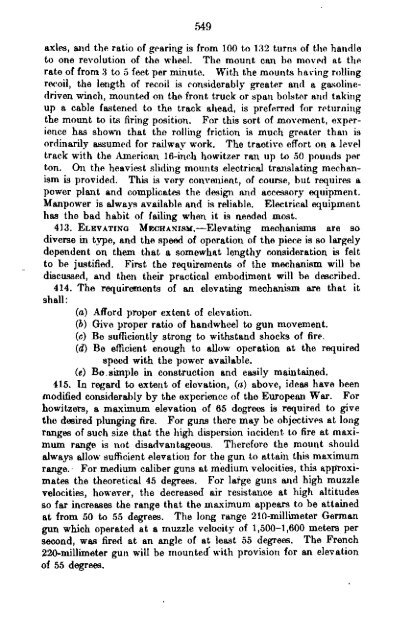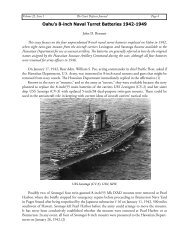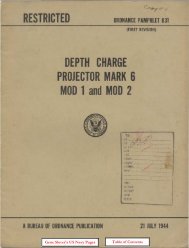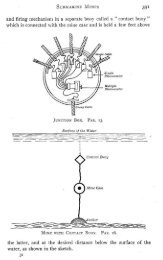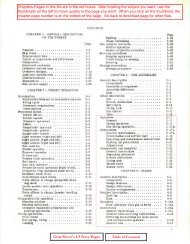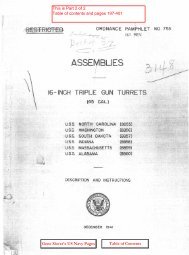...Railway artillery - Personal Page of GENE SLOVER
...Railway artillery - Personal Page of GENE SLOVER
...Railway artillery - Personal Page of GENE SLOVER
You also want an ePaper? Increase the reach of your titles
YUMPU automatically turns print PDFs into web optimized ePapers that Google loves.
549<br />
axles, and the ratio <strong>of</strong> gearing is from 100 to 132 turns <strong>of</strong> the handle<br />
to one revolution <strong>of</strong> the wheel. The mount can be moved at the<br />
rate <strong>of</strong> from 3 to 5 feet per minute. With the mounts hadng rolling<br />
recoil, the length <strong>of</strong> recoil is considerably greater and a gasolinedriven<br />
winch, mounted on the front truck or span bolster and taking<br />
up a cable fastened to the track ahead, is preferred for returning<br />
the mount to its firing position. For this sort <strong>of</strong> movement, experience<br />
has shown that the rolling friction is much greater than is<br />
ordinarily assumed for railway work. The traotive effort on 8. level<br />
track with the American 16-inch howitzer ran up to 50 pounds per<br />
ton. On the heaviest sliding mounts electrical translating mechanism<br />
is provided. This is very convenient, <strong>of</strong> course, but requires a<br />
power plant and complicates the design and accessory equipment.<br />
Manpower is always available and is reliable. Electrical equipment<br />
has the bad habit <strong>of</strong> failing when it is needed most.<br />
413. ELEVATING MECHANISM.-Elevating mechanisms are so<br />
diverse in type, and the speed <strong>of</strong> operation <strong>of</strong> the piece is so largely<br />
dependent on them that a somewhat lengthy consideration is felt<br />
to be justified. First the requirements <strong>of</strong> the mechanism will be<br />
discussed, and then their practical embodiment will be described.<br />
414. The requirements <strong>of</strong> an elevating mechanism are that it<br />
shall:<br />
(a) Afford proper extent <strong>of</strong> elevation.<br />
(b) Give proper ratio <strong>of</strong> handwheel to gun movement.<br />
(c) Be sufficiently strong to withstand shocks <strong>of</strong> fire.<br />
(d) Be efficient enough to allow operation at the required<br />
speed with the power available.<br />
(8) Be.simple in construction and easily maintained.<br />
415. In regard to extent <strong>of</strong> elevation, (a) above, ideas have been<br />
modified considerably by the experience <strong>of</strong> the European War. For<br />
howitzers, a maximum. elevation <strong>of</strong> 65 degrees is required to give<br />
the desired plunging fire. For guns there may be objectives at long<br />
ranges <strong>of</strong> such size that the high dispersion incident to fire at maximum<br />
range is not disadvantageous. Therefore the mount should<br />
always allow sufficient elevation for the gun to attain this maximum<br />
range. . For medium caliber guns at medium velocities, this app'roximates<br />
the theoretical 45 degrees. For large guns and high muzzle<br />
velocities, however, the decreased air resistance at high altitudes<br />
so far increases the range that the maximum appears to be attained<br />
at from 50 to 55 degrees. The long range 21O-millimeter German<br />
gun which operated at a muzzle velooity <strong>of</strong> 1,500-1,600 meters per<br />
second, was fired at an angle <strong>of</strong> at least 55 degrees. The French<br />
220-millimeter gun will be mounted' with provision for an elevation<br />
<strong>of</strong> 55 degrees.<br />
Digitized by Coogle


